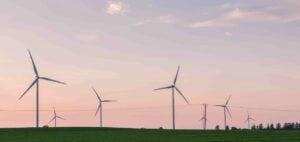BP recently announced its intention to sell its onshore wind energy business in the USA, a decision that is part of a significant strategic shift for the company.
The sale involves assets comprising ten wind power projects in seven states, with a net generating capacity of 1.3 gigawatts.
The company plans to refocus its efforts by integrating the development of its onshore renewable energies within Lightsource bp, a subsidiary specializing in solar power, of which it acquired full control last November.
The move marks a turning point under BP’s new CEO Murray Auchincloss, who is focusing on oil and gas in response to investor pressure and the declining profitability of renewable projects.
BP’s decision to pull out of onshore wind reflects a broader trend in the US renewables sector.
Many companies, including major players such as Ørsted, have recently cancelled or renegotiated power purchase agreements for offshore wind projects.
This situation is exacerbated by rising material costs, high interest rates and supply chain disruptions.
William Lin, BP’s executive vice president for gas and low-carbon energy, pointed out that these assets would be more valuable to another owner, justifying the decision to sell.
BP’s strategic reorientation
BP’s repositioning towards oil and gas represents a radical departure from the strategy of its predecessor, Bernard Looney, who had focused on a rapid transition to more sustainable energies.
Under Looney’s leadership, BP had announced ambitious targets for reducing its carbon footprint and phasing out fossil fuels.
However, increasing pressure from investors, who are concerned about the profitability of energy transition projects, has led to a reassessment of this strategy.
BP’s recent financial results show a tendency to favor investments in more profitable sectors, which led to the decision to sell its wind power assets.
The integration of onshore renewables into Lightsource bp could enable BP to streamline its operations and maximize synergies between its solar and wind projects.
Lightsource bp, as Europe’s largest solar developer, offers BP a platform to develop solar projects while reducing its exposure to the risks associated with onshore wind.
This strategy could also enable BP to focus on projects that offer a better return on investment, while meeting investor expectations.
Renewable energy market challenges
The U.S. renewable energy market is facing significant challenges that are complicating the viability of wind and solar projects.
Rising material costs, particularly in the context of inflation and supply chain disruptions, have led to project delays and cancellations.
High interest rates are also making it more expensive to finance new projects, discouraging investment in the sector.
These factors have a direct impact on the profitability of renewable energy projects, prompting some companies to review their strategies.
BP’s decision to withdraw from onshore wind power could also be interpreted as a response to these market challenges.
By focusing on more profitable assets and integrating its initiatives into a more coherent structure, BP is seeking to navigate a difficult economic environment.
Companies in the sector must now demonstrate agility and innovation to adapt to changing market conditions, while meeting growing expectations in terms of sustainability and social responsibility.
Outlook for BP
Going forward, BP will need to continue to assess its strategic priorities against a backdrop of rapidly changing investor expectations and market conditions.
Energy transition remains a major concern, and although BP is refocusing on oil and gas, it is likely that the company will also need to demonstrate its commitment to sustainable practices.
Lightsource bp’s asset management will be crucial to the development of profitable solar projects, and BP will need to navigate skilfully between short-term profitability and long-term sustainability goals.
In sum, BP’s decision to sell its US onshore wind power business illustrates the challenges facing the renewable energy sector, as well as the need for companies to adapt to an ever-changing economic environment.
BP’s ability to effectively integrate its renewable energy initiatives into a coherent strategy will be critical to its future success.






















